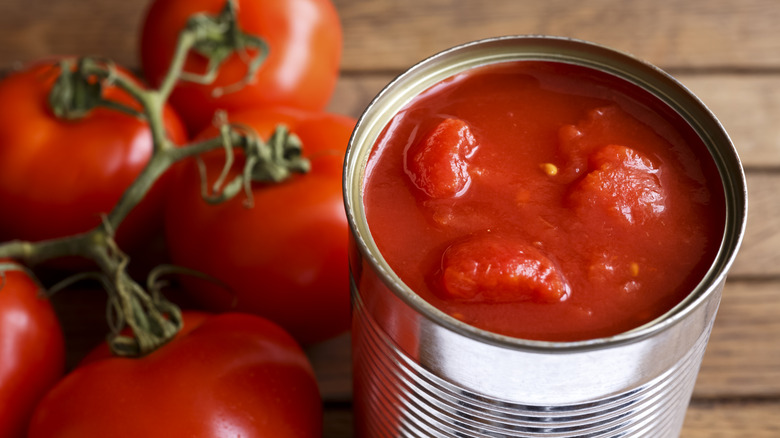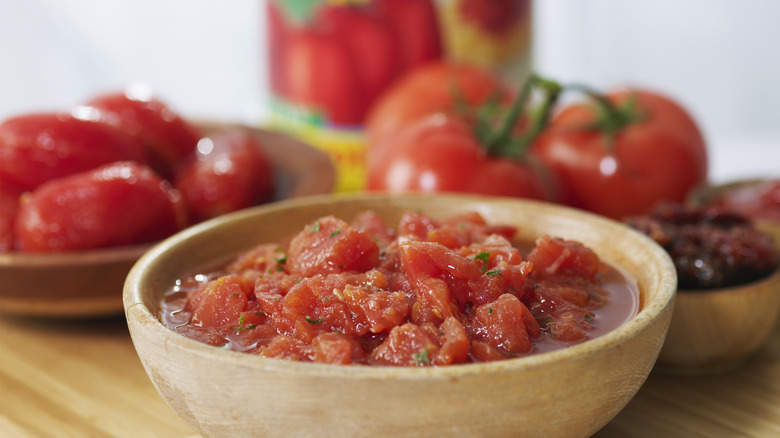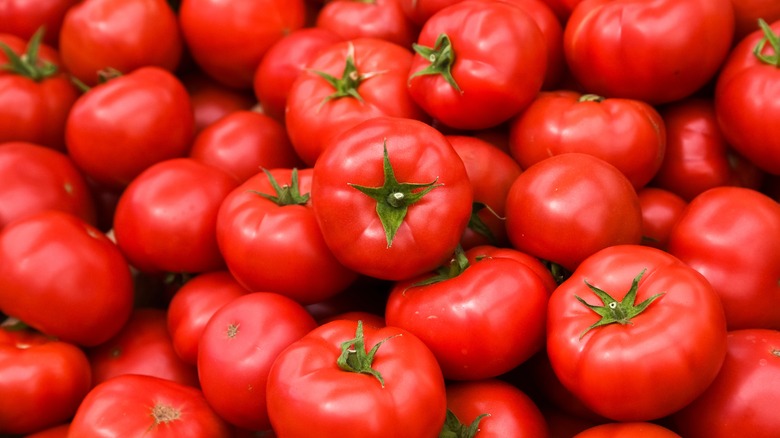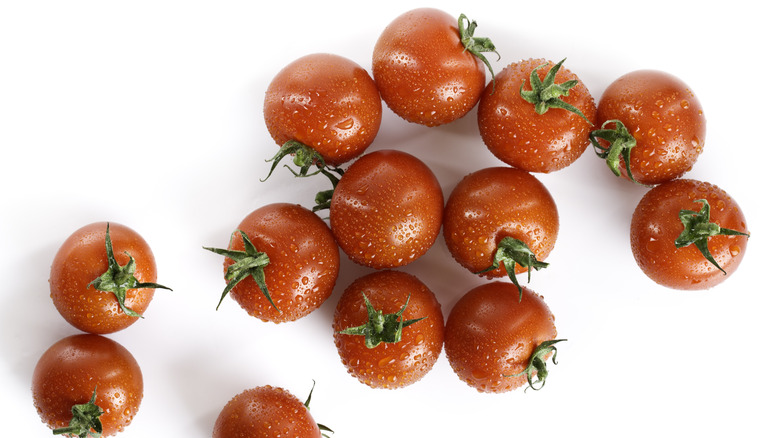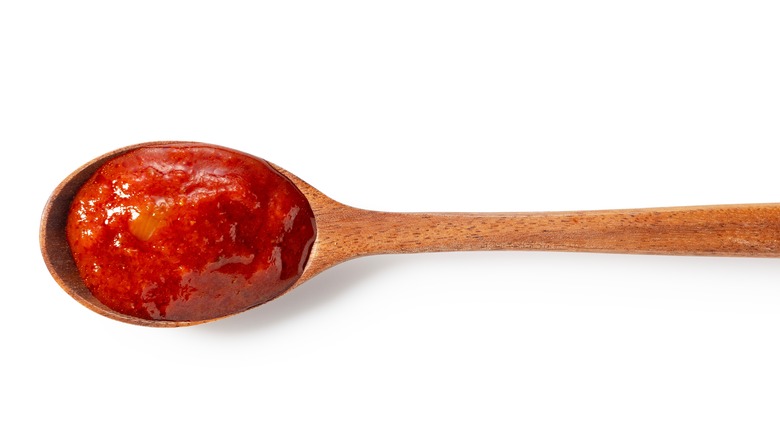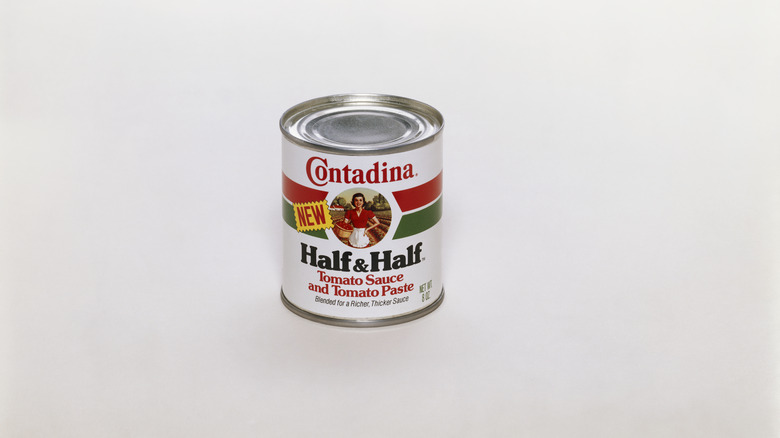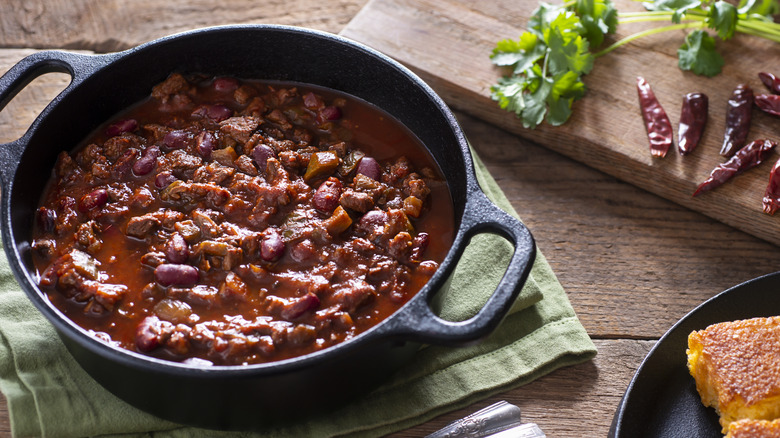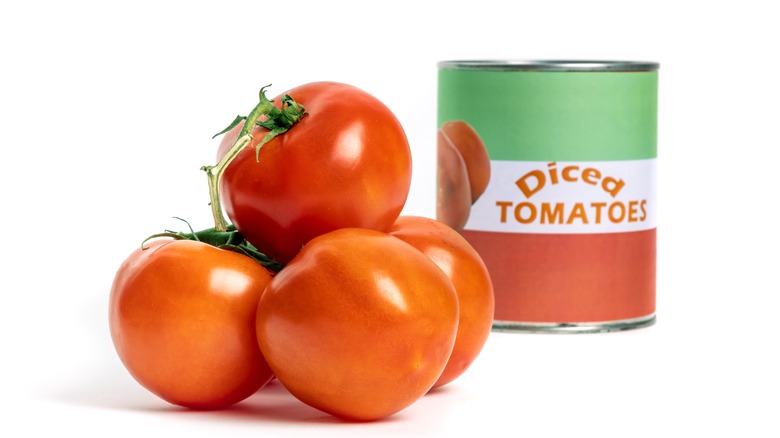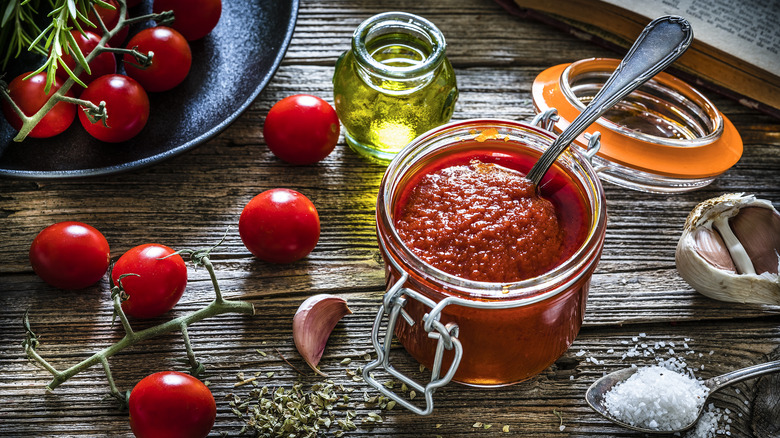The Ultimate Guide To Canned Tomatoes
Canned tomatoes are a must-have in every pantry. Whether they're stewed, diced, pureed, or even in the form of tomato sauce or tomato juice, this is something that every good chef always keeps on hand. Homemade pizza sauce, salsa, pasta sauce, soup ... there's no end to the list of recipes you can use canned tomatoes in.
In many ways, they're just as good or even better than the fresh version, especially since they can last for years in your kitchen cabinet if you store them properly. So, if these little store-bought tin cans of magnificence are so great, you should know everything there is to know about them, right? That's where we come in. This article will fill you in on what canned tomatoes are, how they're made, when they might be better to use than the fresh kind, and just about everything else you ever wanted to know. Let's dig in.
What are canned tomatoes?
Canned tomatoes are simply tomatoes that have been processed (often diced, roasted, juiced, or otherwise prepared) and put into cans in the interest of extending their shelf life. The history of canned tomatoes starts with, as one might guess, fresh tomatoes. These delicious, acidic red fruits were domesticated by the Aztecs starting around 500 B.C. and introduced to Europeans in the late 15th and early 16th century. From there, they caught on in Italy and France before eventually gaining popularity in the United States in the early 1800s. It took a while for tomatoes to become trusted and enjoyed there, but they soon became so popular that some "doctors" were even claiming they had curative properties.
The only drawback to this tomato craze was that fresh tomatoes don't last very long. So, people began to come up with ways to preserve them. In 1847, a gardener named Harrison Woodhull Crosby, who worked at Lafayette College, invented a way to can tomatoes at home that was used until 1890, when improved technology and machinery made commercial tomato canning possible.
From there, the industry continued to improve with the introduction of other new technologies like mechanical harvesters for the tomatoes and juice extractors to make canned tomato juice. Now, the United States — California, in particular — produces between 10 and 12 million tons (yes, tons) of tomatoes for canning purposes each year. That's a lot of canned tomatoes!
How are canned tomatoes made?
Canning tomatoes is not as simple as just plunking some tomatoes into a can and sealing it up. A lot more goes into it, starting with the growing process. Most canned tomatoes are grown on farms specifically devoted to this purpose, where they're usually planted in the spring months. They ripen in the late summer or early fall, after which they're harvested and brought to a plant for processing. Once there, all the flawed tomatoes (ones that were damaged or have spots or diseases) are sorted out and the rest are separated by color and size. They're then washed with water and disinfectants to ensure that they're free from bacteria or dirt, before being blanched. This blanching process (which usually consists of boiling or steaming them very briefly) loosens up the tomatoes' skins, which are then removed.
Next, the tomatoes are processed into whatever form they'll be canned in, which could involve cooking, steaming, dicing, juicing, or pureeing them. Then, finally, they're placed into cans and sealed before being sent off to warehouses and, eventually, your grocery store.
Fresh tomatoes vs. canned tomatoes
Many people have a deep-seated belief that fresh vegetables are always superior to their canned counterparts. This is actually not true at all, especially in the case of canned tomatoes. If you were to consult the nutritional facts, you would see that there are very few places where the two differ. They have similar amounts of fat, protein, fiber, sugar, and calories in general. While fresh tomatoes have more folate and Vitamin A, C, and K, canned tomatoes contain a lot more calcium and lycopene, the latter of which is a powerful antioxidant that's given to the body in a more usable form from canned tomatoes than fresh.
Canned tomatoes do differ from fresh ones in terms of taste, however, and they can't always be easily swapped out for one another. Fresh tomatoes, for instance, are better for uncooked or lightly cooked dishes like salads, because they have less moisture and have a crisper bite. Canned tomatoes can save you a lot of time in many cooked, moist dishes like sauces and soups, however, and tend to have a stronger flavor.
What do canned tomatoes taste like?
To say that canned tomatoes taste just like fresh tomatoes is just not accurate. Thanks to their processing, canned tomatoes have a fuller, richer, flavor than their fresh-picked counterparts. They have a savory, umami-rich flavor that tends to be fairly intense. They may be sweeter or more acidic, based on the type of tomato used (cherry tomatoes are usually sweeter than other tomatoes), and typically canned tomatoes have some added salt for both preservation purposes and flavor.
Many canned tomato products also have added herbs and spices, with some tomato sauces being ready to eat right out of the can. You will find that even the "plain" canned tomatoes are typically more consistent in terms of flavor than fresh tomatoes as well, though, as fresh tomatoes are more likely to have different flavors based on things like how much water the plants received while growing and other conditions they may have been exposed to.
Varieties of canned tomatoes
We've been talking about "canned tomatoes" throughout this whole article, but this term can actually encompass many different things. Whole peeled tomatoes, for instance, are exactly that — entire, peeled tomatoes packed into a can with tomato juice or tomato puree. They're great for recipes that take a while to cook, and can be turned into tomato sauce, tomato soup, and more. Or they can be used as a replacement for canned diced or crushed tomatoes with a few strokes of a knife. Speaking of which, canned diced tomatoes are firmer and hold their shape better than whole tomatoes, making them ideal for chunky dishes like salsa or slow-cooked chili.
Crushed tomatoes are about two steps away from tomato sauce, and are great for things like lasagna, chicken Parmesan, and minestrone. Puréed tomatoes are a step closer, and have been strained and seeded, making them a good choice for tomato soup or similar dishes. Finally, we get to tomato sauce itself, which has been blended, cooked, and concentrated to make it as tomato-ey tasting as possible. With the addition of seasonings and some cooking time, tomato sauce can easily become marinara sauce or pizza sauce. Lastly, we also have tomato paste, which is a dryer, highly concentrated form of tomato used in many widely varied recipes, and stewed tomatoes which have already been seasoned and cooked with other ingredients, making them sweeter and more flavorful.
How to cook with canned tomatoes
Canned tomatoes are one of the best things you can keep in your cupboard because they're just so versatile. You can, for example, add some canned diced tomatoes to some sauteed onion and garlic, along with some basil or oregano, to make some delicious pasta sauce. Or you can use that same can of diced tomatoes to make some homemade salsa with the addition of some chopped onions, peppers, and jalapenos. You can also use them for bruschetta, soups, chili, or meat sauce.
If you have tomato sauce instead, you can make things like pizza, pasta sauce, or tomato soup. With crushed tomatoes, you can whip up some shashuka with poached eggs and onion. Tomato paste, which can come in either a can or a tube, can be caramelized and used as a base for sauces, chilis, braises, soups, and marinades. Whole canned tomatoes can be used for all these recipes and more, but keep in mind that no matter which type of canned tomatoes you choose, you have to cook the tomatoes for a while to let their flavors settle and mingle with your other ingredients, to get the best results.
Where to buy canned tomatoes
Fortunately, canned tomatoes are pretty ubiquitous. You can find them at any grocery store, big or small, in the canned section. So, whether you're a fan of big chains like Walmart and Kroger or you prefer doing your shopping at smaller businesses, you won't have to look very hard to find the canned tomatoes you need. You will also likely have a wide selection of decently priced brands to choose from, as there are many big (and small) players in the canned tomato market like Del Monte, Hunt's Mutti, Contadina, and Red Gold. And that's not even counting the store brands!
If you like to buy your groceries online instead, you can find canned tomatoes on the corresponding websites of brick-and-mortar stores like Walmart, Target, and Kroger. You can also find them on websites that have a wider variety of products from different market categories such as Amazon. So, unlike some more niche products, canned tomatoes are one food you should have no trouble tracking down.
Purchase Amazon Fresh, Petite Diced Canned Tomatoes on Amazon for $0.99.
Purchase Contadina Whole Peeled Tomatoes at Walmart for $6.00.
Purchase Hunt's 100% Natural Diced Tomatoes at Target for $1.49.
Nutritional information about canned tomatoes
The world is full of different varieties and brands of canned tomatoes, but listing the nutritional information for every single one of them would probably fill a book whose length rivals that of Leo Tolstoy's "War and Peace" so we will just stick to a general look at a standard can of tomatoes here. In a serving of 190 grams, there are just 30 calories, making this as nutritious a choice as fresh tomatoes in that regard.
Looking at the fat content, canned tomatoes have just 0.5 grams of fat, with 0.1g being saturated fat, 0.2 grams being polyunsaturated fat, and 0.1 grams being monounsaturated fat. There's no cholesterol to speak of here, so things continue to look good for your diet. A can of tomatoes also contains 3.6 grams of dietary fiber and 1.5 grams of protein. You can even get five percent of the recommended daily value of calcium with canned tomatoes as well, along with eight percent of the recommended daily value of potassium and six percent of your iron intake.
Canned tomatoes also have 4.8 grams of sugar per serving, but the only potentially worrisome statistic for a typical can of tomatoes is its salt content. In a 190 grams serving, there are 219 mg of sodium, which is 10 percent of the recommended daily value.
How to store canned tomatoes
The whole purpose of canning tomatoes is to make them last much longer than they would have otherwise. So you may not be surprised to learn that canned tomatoes can be kept in the pantry for up to two years without going bad. You should make sure, though, that they are in a cool, dry place, as moisture can cause rust and corrosion on or inside the can. You should also ensure that the temperature of your pantry or cabinet never goes below the freezing point, as the freezing of canned foods followed by thawing at unsafe temperatures can lead to food poisoning.
Once the can has been opened, you can store the tomatoes in an airtight container in the refrigerator. The USDA recommends that they can be kept for five to seven days — any time longer than that may lead to spoilage. A glass box or bowl works best here, but you can also use plastic. Just be aware, however, that tomatoes and tomato sauce tend to stain plastic storage containers.
